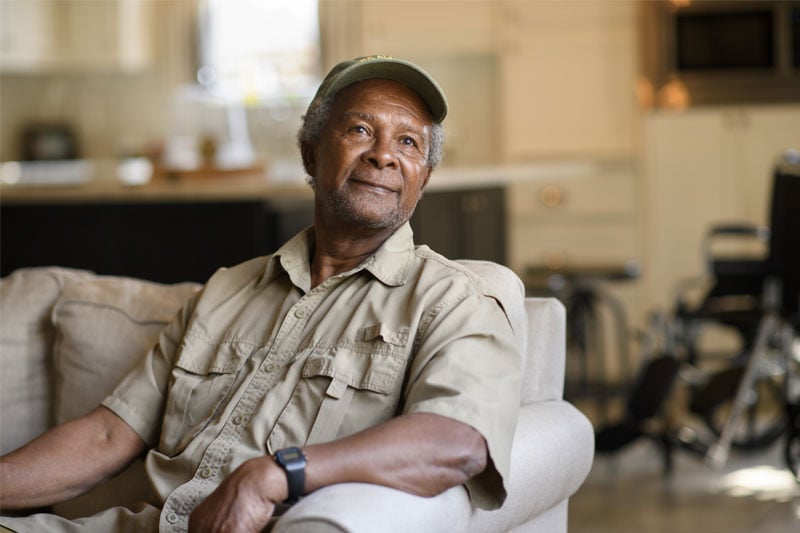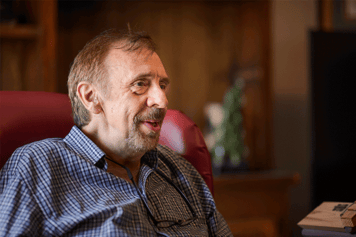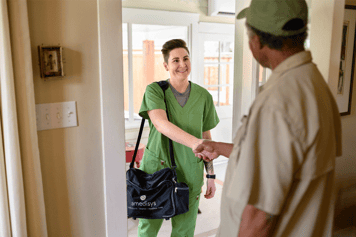In the United States today, suicide in the elderly is a pressing concern for families, healthcare providers and policymakers. The high suicide rates in older adults, coupled with higher rates of loneliness, isolation and depression, mean that you should be aware of the causes, warning signs and ways to reduce the risk of suicide for elderly loved ones.
Before we take a closer look at these key details, please note that you can call or text 988 anytime, day or night, for emergency assistance if you or someone in your life is having suicidal thoughts, describing suicidal intentions or having a mental health crisis. Additionally, Veterans can press “1” after dialing 988 to connect directly to the Veterans Crisis Lifeline which provides assistance to Veterans, including service members, National Guard and Reserve members, and those who support them.
What are common causes of suicide in the elderly?
According to the National Institute of Mental Health, suicide affects nearly 25 out of 100,000 adults ages 65-74 and 40 out of 100,000 adults ages 75 or older. This means that although older adults make up just 12% of the population, they equal 18% of all suicides. There are many reasons for higher suicide rates in the elderly population. These include:
Loneliness and isolation
Older adults often experience social isolation and loneliness. This can happen due to family and friends passing away, living alone, challenges in mobility and transportation, chronic health conditions and even barriers like vision and hearing loss.
[action 1]
There are many known health impacts of loneliness. This includes an increased risk of premature death, higher rates of health problems like dementia, heart disease and stroke and higher numbers of hospitalizations and emergency room visits. It also creates an increased risk of depression, anxiety and suicide.
Chronic health conditions
Our bodies change as we age, and that often means health conditions that may cause discomfort, affect our mobility, impact memory and cognition and generally decrease quality of life. In fact, according to the American Psychological Association, 92% of older adults have at least one chronic health condition, and 77% have two or more.
Financial insecurity
Increasingly, older adults are affected by financial challenges. A recent study released by the National Council on Aging found that as many as 80% of older adults live in households faced with problems with affording basic or long-term care needs.
Depression
Loneliness, chronic health problems, dementia, the loss of friends and loved ones who have passed away and reduced ability to care for oneself can all contribute to increased risk of depression in older adults. Depression is not a normal part of aging. Untreated, depression can lead to suicidal thoughts and actions.
How can you reduce the risk of suicide in the elderly?
Knowing that all of the above problems can increase the risk of suicide in the elderly, what can you do to reduce that risk? There are several steps you can take to help an older adult in your life who may be struggling. Let’s consider several important actions:
Have a Conversation
An older adult may not openly discuss the challenges they are facing, especially if they are worried about being a burden to those around them. Ask questions and make observations: “I noticed you might be having some trouble getting out to visit friends. I would like to help. What is the best way I can do that?”
Help coordinate healthcare
Visits to the doctor, scheduling appointments, following up on testing, filling prescriptions or even accessing care may be overwhelming, especially as many of these tasks require familiarity with technology. For eligible older adults, home health care may meet their needs and help reduce loneliness. Or, palliative care to manage chronic pain or complex health conditions may be appropriate.
Address signs of depression
Remember, depression is not a normal part of aging. If you notice signs of depression in your loved one, such as persistent sadness, hopelessness, helplessness, irritability, decreased energy, trouble concentrating or making decisions, difficulty with sleeping and changes in eating habits, it’s important to seek professional help.
Take steps to prevent loneliness
Preventing loneliness is crucial to reducing the risk of suicide and providing connection to others who can be alert to warning signs of suicide in an older adult. Reaching out by phone, spending time with an older adult and helping facilitate their connection to the outside world can all reduce isolation.
What are warning signs of suicide in the elderly?
It’s important that you are aware of the warning signs of suicide in the elderly so that you can be alert to changes in an older loved one. The Substance Abuse and Mental Health Services Administration (SAMHSA) has published a list of the following warning signs of suicide:
Signs of immediate danger:
- Threatening to hurt or kill oneself or talking about wanting to hurt or kill oneself
- Looking for ways to obtain firearms, pills or other ways to hurt or kill oneself
- Talking or writing about death, dying or suicide when they never have done this in the past
Signs of potential danger in the future:
- Sudden or dramatic mood changes
- Feelings of hopelessness
- Increased alcohol or drug use
- Uncontrollable rage or anger, or expressing desire for revenge
- Reckless behavior or an increase in risky activities without regard for consequences
- Withdrawing from family, friends or other social connections
- Lack of purpose in life, feeling like there is no reason for living
- Increased anxiety, agitation or trouble sleeping (sleeping either too much or too little)
- Feeling trapped, or as if there’s “no way out”
What should I do if an older adult is suicidal?
If you have experienced any of the above warning signs of suicide or noticed them in a loved one, it’s important that you act at once. The 988 Suicide and Crisis Lifeline is a national phone number available 24/7 by text or call to help with mental health, substance abuse or suicidal crisis. Veterans can also press “1” after dialing 988 to connect directly to the Veterans Crisis Lifeline.
Once any immediate crisis is resolved, it’s important to follow up with your loved one’s team of healthcare providers. Treatment for the underlying causes of suicide, including chronic health conditions and depression, will help reduce future emergencies.
Remember, you aren’t alone in preventing suicide
Learning about the causes of suicide in the elderly, how to reduce the risk of suicide and addressing warning signs can all help you to support the older adults in your life. Although suicidal behavior can be a source of worry, you or your loved one do not have to face this alone.
Having open conversations about your concerns and seeking help from professionals such as physicians, licensed therapists and community resources like your local Area Agency on Aging can all provide added support.
For help finding health care at home options for an older adult, contact Amedisys today.



